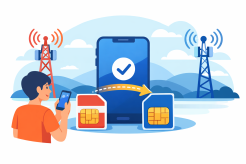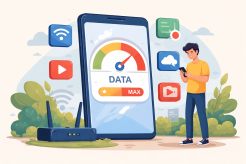What You'll Need for Fiber-Optic Internet Installation

Fiber-optic internet connections are by far the quickest and most dependable option, but getting those precious beams of internet light to your gadgets can be a challenge. Here's all you need to know about fiber-optic internet if you're just getting started, or if you're still thinking about it.
Also, Read
Resources Guide for free Internet, Computers, and Tech for Students
Ultimate Guide to Choosing The Cheapest Internet Service Provider 2021
Can I use my own wireless router with Spectrum Internet?
Need Fiber Internet?
Call us Today at 1-888-317-7540
What is fiber-optic internet and how does it work?
Because the internet's backbone is made up of massive fiber-optic cables, fiber is already an important element of everyone's internet experience. Fiber-optic cables are comprised of thin glass or plastic fibers that carry data as light pulses over vast distances. They can carry significantly more data, are less prone to data loss, and are entirely resistant to electromagnetic interference as compared to metal lines (as you might get from solar storms). Fiber-optic cables span continents and oceans, and they can be counted on to do their job whether they're at the bottom of the sea or just beneath your feet.
Light-filled tubes
Information is transferred as light pulses in fiber optics. A fiber-optic tube's interior works as a mirror, reflecting light off the inside walls and down the tube to its destination. Because information travels at the speed of light, you can move a large amount of data very quickly. Fiber-optic cables come in a variety of shapes and sizes—some are more durable than others, and some can go longer distances—but they all transport data swiftly and reliably.
At some time, all internet traffic will pass over fiber optics, but in a perfect world, fiber would reach all the way to your home. Fiber to the home (FTTH) not only provides you with the fastest and most stable internet connection currently available, but it also saves internet service providers (ISPs) money in the long run by requiring far less maintenance and resulting in fewer customer complaints. As a result, fiber internet services are frequently comparable to or less expensive than other forms of connections in the same location. It's a win-win situation!
The last mile
Most fiber networks, unfortunately, do not extend all the way to the home. The "last mile" refers to the distance between the internet's core fiber cables and the residences of internet users (even though the actual distance will vary). Coaxial cables, phone lines, or wireless signals commonly make up the last mile of a link. This is how fiber internet differs from other types of internet. Customers who have fiber have fiber from their home to the rest of the internet infrastructure. DSL or cable The majority of the distance between a customer's home and the rest of the network will be covered by fiber, while the final mile will be delivered by coaxial cables or copper phone lines.
These outdated technologies become the bottleneck, resulting in slower speeds, more latency, and a less dependable connection. That's why, despite the fact that everyone's data flows over the same fiber-optic lines, some people get a far superior overall experience.
Why is fiber so beneficial?
So, what's the big deal about fiber? Fiber has a lot of real practical benefits that other internet technologies can't match, aside from being the cool, cutting-edge technology for accessing the internet. High download speeds, symmetrical upload speeds, stability, and scalability are the key benefits of fiber.
High-speed Download
It should come as no surprise that fiber is the fastest way to link your home and all of your gadgets, given that it is used to connect entire continents with billions of internet users. Most fiber subscriptions now offer speeds of 1 Gbps (1,000 Mbps), which is more than most individuals can utilize—even if they invite all of their friends over to use their Wi-Fi.
Many cable internet services can also achieve 1 Gigabit per second, but the two technologies are not interchangeable. As we push the technology to its physical limitations, cable speeds are certain to grow. Fiber, on the other hand, isn't even breaking a sweat yet. The gap between cable and fiber will only widen as home internet rates increase.
Symmetrical Upload Speeds
Although cable download speeds are comparable to fiber, cable upload speeds are only a fraction of those speeds. The upload and download speeds on fiber, on the other hand, are symmetrical. This means that if you can download at 1 Gigabit per second, you can upload at 1 Gigabit per second as well.
Most online activities, like streaming videos, reading the news, or simply perusing the web, necessitate very little upload speed, hence download speed is crucial. Upload speed becomes more crucial as more people use the internet for video conferencing and live-streaming. In terms of upload speed, nothing compares to fiber.
Connectivity
Fiber connections not only have the fastest promised speeds, but they also keep them more consistently than other connections. Almost every type of internet is susceptible to some form of interference. Some instances are as follows:
- When there is more internet traffic in your community, cable internet speeds drop down.
- The farther you are from the provider's central office, the slower DSL internet becomes.
- Weather can cause satellite internet to go down.
Fiber is unaffected by any of these issues. It also does not demand as much upkeep as other forms of internet. This means you won't have to deal with outages as frequently as you would with cable or DSL due to aging cables needing to be replaced.
Scalable
Fiber is not only the best internet available right now, but it is also the best option for the future. Fiber uses significantly higher frequencies and loses less energy over long distances since it transmits data using light rather than electricity. This means that fiber can transmit far more information over a longer distance than metal wires can.
Dark fiber is a type of fiber-optic cable that is sometimes used in the installation of fiber-optic cables. Extra fibers in the cable that aren't originally utilized are referred to as dark fiber. Dark fibers can be turned on to provide additional capacity when the quantity of internet traffic in a certain location grows, rather than digging up and laying larger connections.
How to self-install a fiber connection
Because installing fiber sometimes necessitates laying new cable and setting up specialist equipment, some fiber providers do not provide the option of self-installation. You'll need to hire a professional to put it up for you, which might be quite costly. These are the procedures to self-install fiber internet if your ISP does not require a specialist to set up your connection:
- Determine the location of your fiber network terminal.
- Connect the network box to the fiber terminal.
- Connect your network box to your computer.
- Connect the network box to your device.
- Create a Wi-Fi network in your home.
These processes are similar to those for self-installing other forms of internet, however, there are a few key distinctions. Let's look at each one in more detail.
Related Posts

Tue, Jan 13, 2026 9:36 PM
cheap internet dealsHow Long Does It Take to Switch Phone Carriers?
Learn how long it takes to switch phone carriers, including number porting, plan selection, and tips for a seamless transition to better service and savings.

Tue, Jan 13, 2026 9:03 PM
TechnologyHow eSIM Helps You Stay Connected While Traveling Abroad
Discover how eSIM helps travelers stay connected abroad with instant activation, cost-effective plans, and reliable mobile data for seamless international travel.

Mon, Jan 12, 2026 11:04 PM
SubscriptionHow to Use Your Cell Phone Internationally Without Breaking the Bank
Learn how to use your cell phone internationally with data plans, local SIMs, and Wi-Fi tips to stay connected without high roaming fees.

Mon, Jan 12, 2026 10:51 PM
WifiHow RCS Works: The Future of Messaging on Your Phone
Learn how modern messaging works and why it’s the future of texting with high-quality media, read receipts, and interactive group messaging.

Fri, Jan 9, 2026 3:20 AM
RegulationsWhy Apps Keep Using Your Data in the Background (And How to Stop It)
Learn why apps keep using data in the background, how it affects your data cap, and simple ways to reduce background data usage without losing functionality.